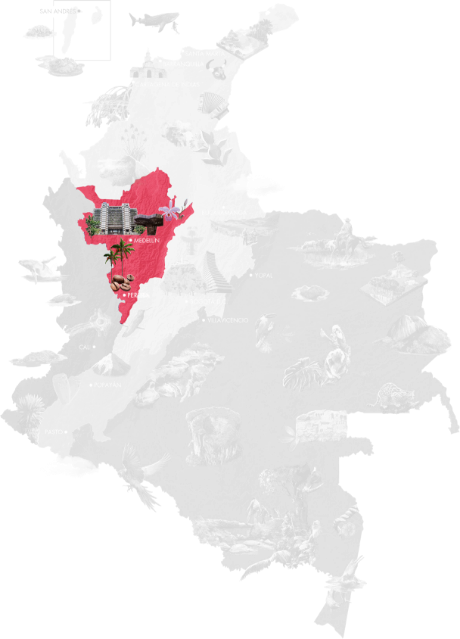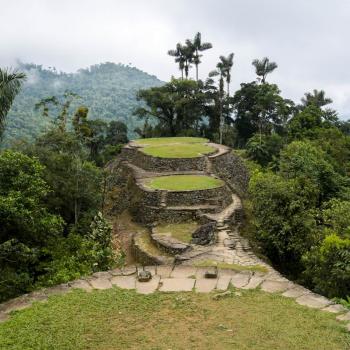Even the most experienced traveler would find it hard to resist the charms of the coffee-scented mountains of the Western Colombian Andes. Filled with brightly colored towns and enchanting landscapes of the country's main coffee-growing region, they seem straight out of a fairy tale, brimming with flowers.
The protagonists of this story are the paisas, the friendly inhabitants of the region known for their hardworking culture and great hospitality. Whether in the modern city of Medellín, one of the most dynamic urban centers in South America, or in one of the many tranquil mountain towns, the paisas take great pride in their region and love nothing more than sharing its charms with visitors.
Located in the heart of a stunning valley, Medellín is an excellent place to start an adventure through these extraordinary lands. Like many places in the region, this city enjoys a perpetual spring-like climate, perfect for soaking in the atmosphere of a city filled with parks and outdoor spaces, including the immense Parque Arví and the Plaza de Botero, which features works by the region's most beloved artist.
Visitors can also travel to the mountainous neighborhoods to learn firsthand about the city's transformation or take the cable cars for a better view of one of the most modern cities before enjoying some of the best culinary and nightlife scenes in the country.
Medellín is renowned for its incredible Feria de las Flores, during which the silleteros from the surrounding mountain areas come to the city to showcase their elaborate floral arrangements.
While the main urban center of the region is undoubtedly a marvel, the rural area of the Western Andes is equally special. Like a spectacular canvas that uses all the colors of the palette, the region is a brilliant land of perfectly tended slopes and lush valleys filled with flowers that attract countless exotic birds. It is a place where the immaculate two-tone farmhouses with brightly painted windows overlook the crystal-clear rivers that descend vigorously from the mountains.
Here, agriculture and nature coexist in harmony, partly as a result of the omnipresence of the perpetually green coffee shrub, which seems to have been designed specifically for these mountains.
But coffee is more than just a crop; it is a way of life. While coffee harvesting occurs in different regions of the country, nowhere is it as important as in the local culture of the Western Andes. The bond between the coffee bean and these lands is so essential that the region has been declared a World Heritage Site by UNESCO, designating it as the Coffee Cultural Landscape.
From the skilled pickers who deftly balance on steep hillsides to handpick the beans to the colorful jeeps loaded with the harvest and the bustling cafes in the picturesque town squares, coffee energizes the Western Andes, and visitors can follow the process step by step from planting to savoring a cup of coffee.
Three of the southernmost departments of the Western Andes form the Coffee Axis, the traditional heart of coffee production in Colombia. The three departmental capitals of the axis—Manizales, Pereira, and Armenia—are excellent starting points for visiting coffee plantations. For a more immersive experience, visit one of the fabulous rural towns in the area, where farmers and visitors come together over a cup of coffee.
The mountains of the Coffee Axis were first colonized by paisas from Antioquia in search of fertile lands. The first settlers brought with them a love for the countryside, good cuisine, and distinctive architecture.
Salento is known for its colorful houses and traditional coffee atmosphere. It is also the gateway to the must-see Cocora Valley, with its towering wax palms, the tallest in the world.
Near Filandia, you will find some of the best-preserved paisa architecture in the region, with its perfectly painted two-story houses and incredible wooden balconies. This place is also known for its traditional crafts.
The Coffee Axis is also the main gateway to the magnificent Los Nevados National Natural Park, which offers high-altitude excursions among glaciers, páramos, and lakes. The thermal action of the park's volcanoes heats half a dozen thermal baths in the foothills of the mountains, making this a great invitation to relax after a strenuous day of activities.
As impressive as it is, the park is just one of the many exciting natural attractions of the Western Colombian Andes. With a pleasant climate, excellent infrastructure, and panoramic views, the region is one of the best places in the country for cycling and outdoor adventures.
The foothills of these mountains are home to many small nature reserves, which are among the best bird-watching destinations on the continent. Meanwhile, the Río Claro Nature Reserve, located to the east of the region, focuses on a wonderful crystal-clear river, ideal for bathing, that flows through a narrow canyon surrounded by jungle. Equally clear waters can be found among the cozy rural landscapes of the Río La Miel, where the Western Andes meet the Magdalena River.
Another must-see outdoor experience is the extensive Guatapé Reservoir, which hosts the beautiful small town of the same name. Formed by the flooding of a river valley to generate electricity, it is a labyrinth of endless peninsulas jutting into the cool mountain waters. For the best views, climb to the top of the Piedra del Peñol, one of the largest monoliths in the world.
In contrast to the brightly painted Guatapé, the historic colonial town of Santa Fe de Antioquia is mostly painted white and stone. It was the first major settlement in the region, preserving its original charm and hosting fascinating museums, as well as the iconic Puente de Occidente over the Cauca River, the most impressive suspension bridge in the country.
Perhaps the title of the most charming town of all belongs to Jardín, in southern Antioquia. Nestled in the protective embrace of imposing mountains, its incredible and colorful plaza contrasts with its massive gray stone church. Additionally, the area around the town features caves, waterfalls, rivers, and coffee farms, making it one of the most spectacular in the region—elements that can also be explored in the nearby towns of Jericó and Támesis.
The Western Andes, combining modern and pioneering cities, welcoming inhabitants, rich culture, and a wonderful mountainous landscape, are the ideal destination for all types of travel, whether you want to relax in nature, wine and dine, or have high-energy adventures.
While the main gateway to the region is Medellín's international airport, there are also airports in Pereira and Armenia that receive limited international flights, and Manizales has a connection with Bogotá.
By land, the southern part of the region is just three hours from the city of Cali, while both Medellín and the cities of the Coffee Axis are connected to Bogotá, in the Eastern Colombian Andes, by scenic mountain roads. From Medellín, there are also two scenic routes to the Greater Colombian Caribbean.










































